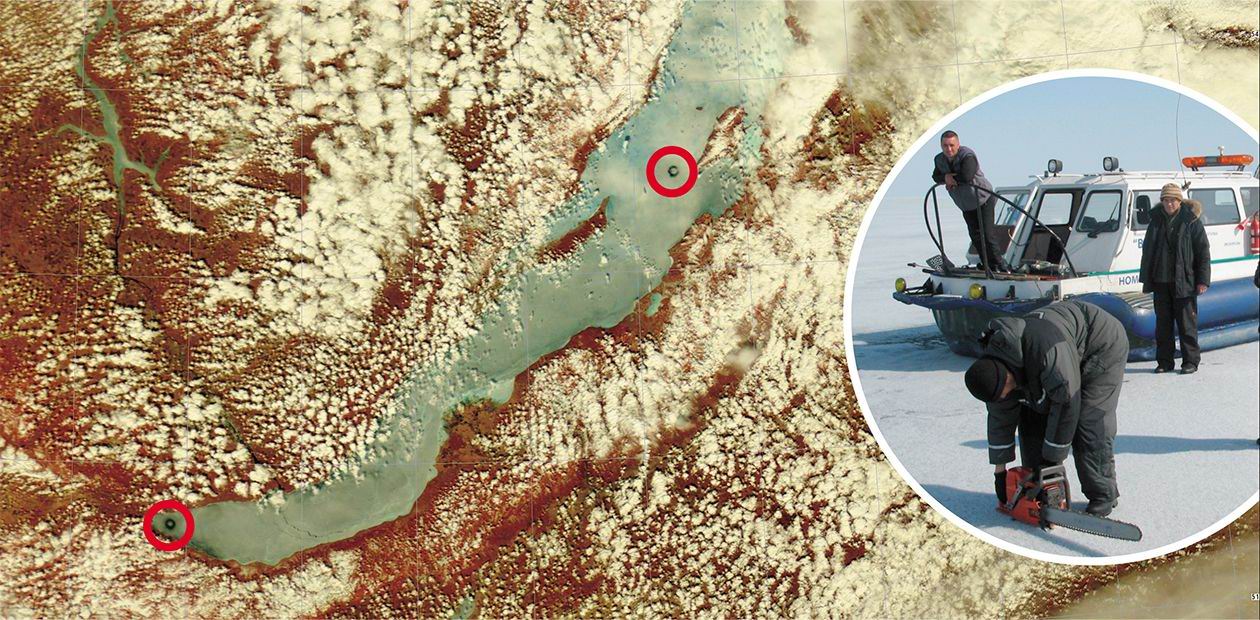The Ringed Baikal
In spring, from the height of “space observation” it is sometimes possible to see huge dark rings several kilometers in diameter in the ice of Lake Baikal. These unusual structures are not yet another mystery inked to extraterrestrials but a natural phenomenon, whose mechanism is being studied as part of an interdisciplinary project of the RAS Presidium
The ice cover of Baikal attracted the attention of scientists as early as the second half of the 17th century. According to Nicolai Spafarii, the first ambassador of Russia in China and an explorer of Siberia, “… in winter Baikal begins to freeze near the day of Epiphany and stays frozen until May, near Nicholas’ Day, and the ice is a sazhen* or more thick, and so in winter people go over it in sledges. But it is very scary, because the sea breaks and divides in two, and the cracks of three or more sazhens wide appear, and the water does not come out on the ice, but soon the ice comes together again with a great noise and roar, and an ice ridge appears there; a great noise and roar can occur under the ice, as if a cannon fires… especially between the island of Olkhon and the Saint Nose peninsula, where the depth is great” (Spafarii, 1882, p. 120).
Systematic studies of the ice regime of Lake Baikal began in 1869—1876, when the exiles B. Dybovskii and V. Godlevskii, who participated in the Polish uprising in 1863, lived in the village of Kultuk. They described in detail ice break-up and freezing of Baikal, for the first time revealing the relationship between the thickness of ice and the snow covering it. They studied hummocked ice, formation of ice cracks and gaps. In their papers published in the proceedings of the East-Siberian Department of the Emperor’s Russian Geographic Society, they also mentioned that in certain areas the lake did not freeze in winter.
Established in 1925 the Baikal Limnological Station of the Academy of Sciences continued studies of ice cover and ice phenomena. As a result, unusual forms of ice cover typical only of Baikal were discovered. For example, there are “sopkas” – hollow cone ice hills up to 6 m high looking like ice marquees that “open” in the direction opposite to the coast. These “sopkas” can stand alone but sometimes they even form a miniature “mountain ridge” (Tsurikov, 1939). The mechanism of the “sopkas” formation, as well as of other typically Baikalian forms of ice, still remains unknown. Today scientists have at their disposal satellite images, which enable them to study previously inaccessible areas and information on the formation and destruction of ice cover over the whole lake. Using photographs from space, in the spring of 2003, scientists from the Limnological Institute SB RAS found an unusual ring structure on the ice surface. It was located near Krestovskii Cape in Central Baikal. Analysis of the satellite images gathered during previous years showed that a similar structure existed at the same place in April 1999.
Further research established that ring structures can be seen quite often on the ice surface, just before the ice breaks. Thus, such a structure was recorded near Krestovskii Cape in 2005 and 2008; at the northern end of the straight of Maloe More (Small Sea) in 2004, 2005, and 2009; in the western part of Southern Lake Baikal in 2008 and 2009, etc. Recently, an increased number of ring structures recorded during a year has been noted; also, they have tended to appear earlier.
On April 4, 2009 a ring structure formed in southern Lake Baikal. Three days later it was investigated by scientists from the Limnological Institute and the Institute for System Dynamics and Control Theory SB RAS. They established that the ice thickness was the same in the center of the ring structure and beyond its boundary; at about 70 cm. However, the ice thickness dropped dramatically (to 43 cm) at a radius of 2 km from the center of the “ring”. The ice here was completely pierced with vertical microcracks.
Some other unusual phenomena were also recorded in the “ring”, with the temperature of the surface water beneath the ice in the central part of the ring about 0.5°C higher compared to that beyond its boundary. In addition, the highest current (about 6 cm/s) was recorded here.
So, what is the reason why these unusual ice structures appear?
They form as a result of upwelling of deep water and increased temperature of the surface water in the central part of the ring structure. This provokes anticyclonic (clockwise) water currents.
In the zone where the current reaches its highest velocity, the vertical water exchange intensifies, which leads to a faster destruction of the ice cover. The dark rings seen on the satellite images are the ring areas characterized by the lowest thickness of ice cover and where the ice is more saturated with water.
The upwelling of deep water can happen due to the eruptions of mud volcanoes located on the lake bottom. However, this hypothesis has still to be proven. At present, comprehensive studies of the mechanism of formation of the ring structures on Baikal ice are conducted in the frame of RAS Presidium project, which involves limnologists, mathematicians, and physicists from four institutes of the Siberian Branch of RAS.
Unique rings in the ice of Lake Baikal are by no means the last riddle that will be presented to us by the largest freshwater lake on the planet
*A sazhen was an old Russian unit of distance equal to 2.1336 meters














